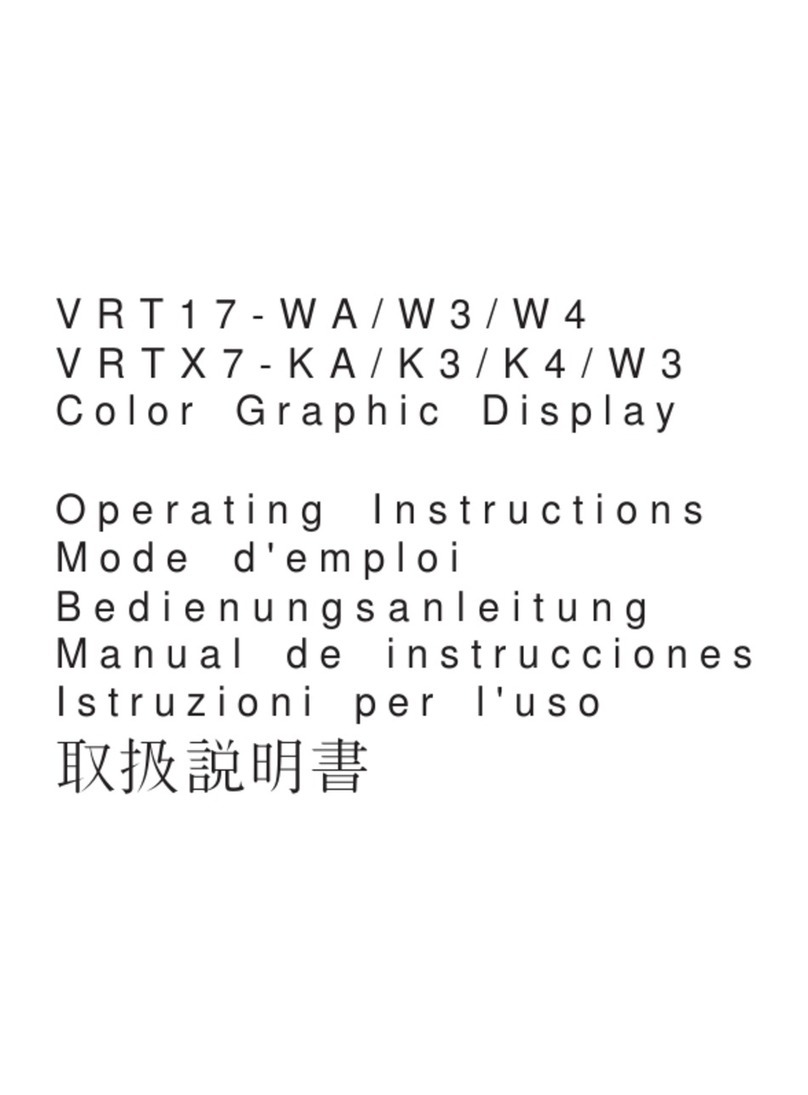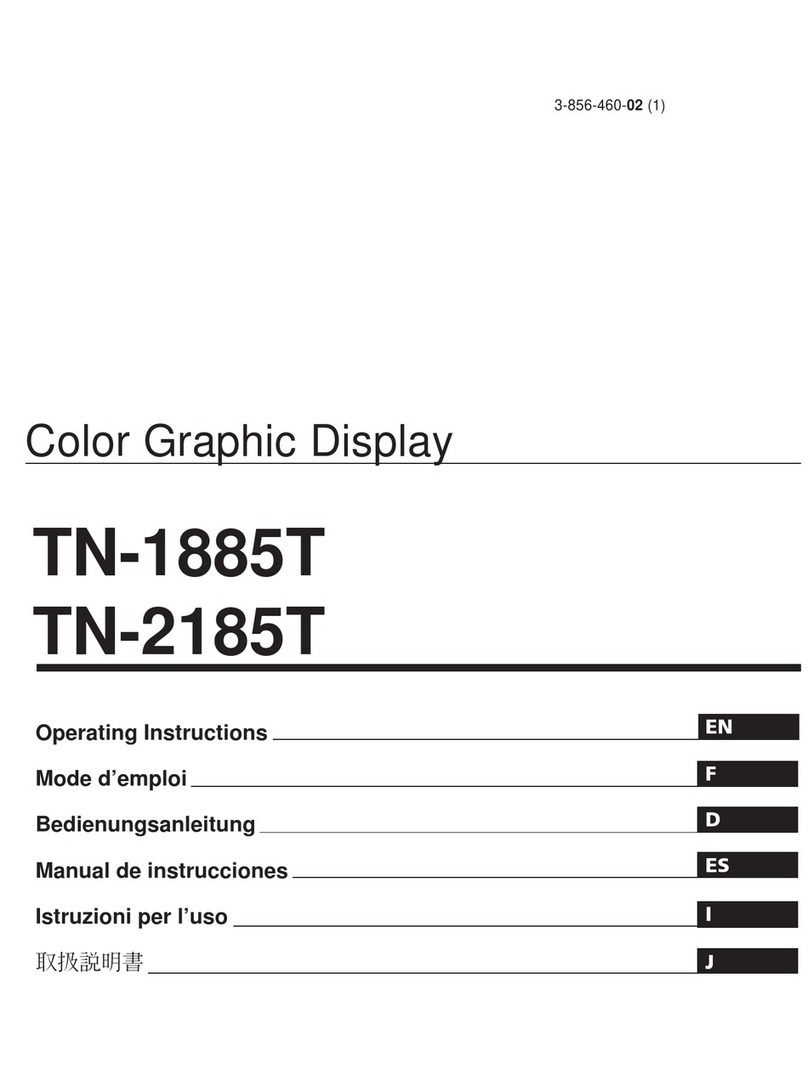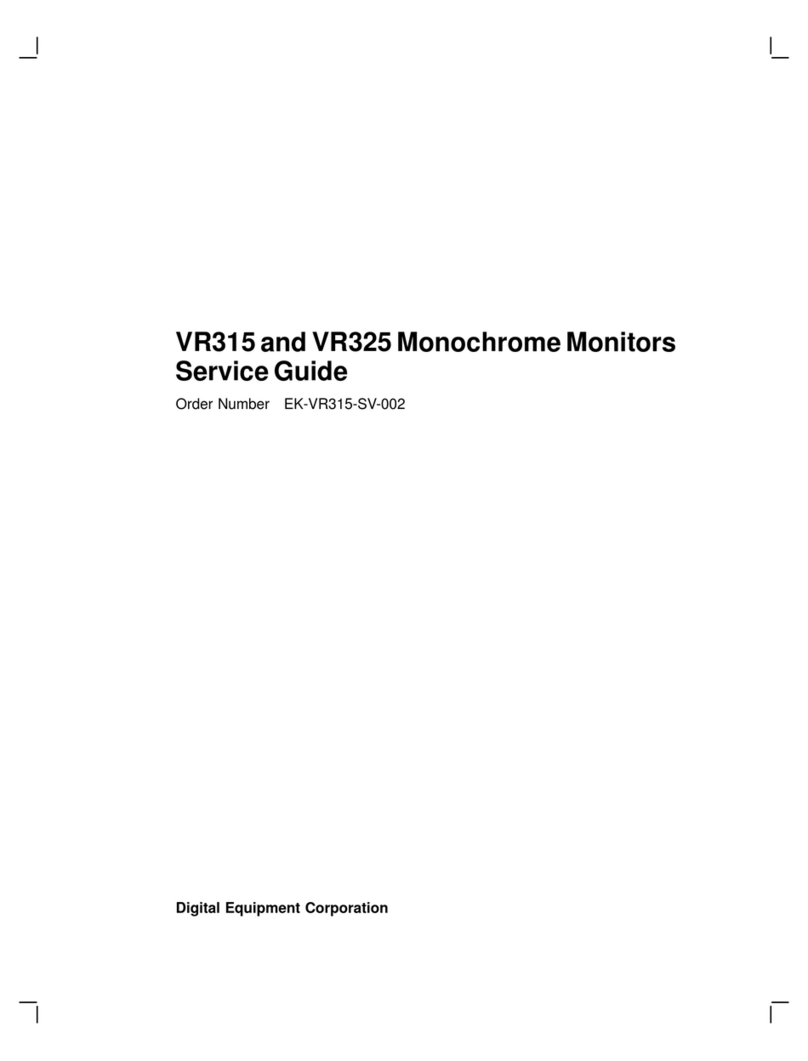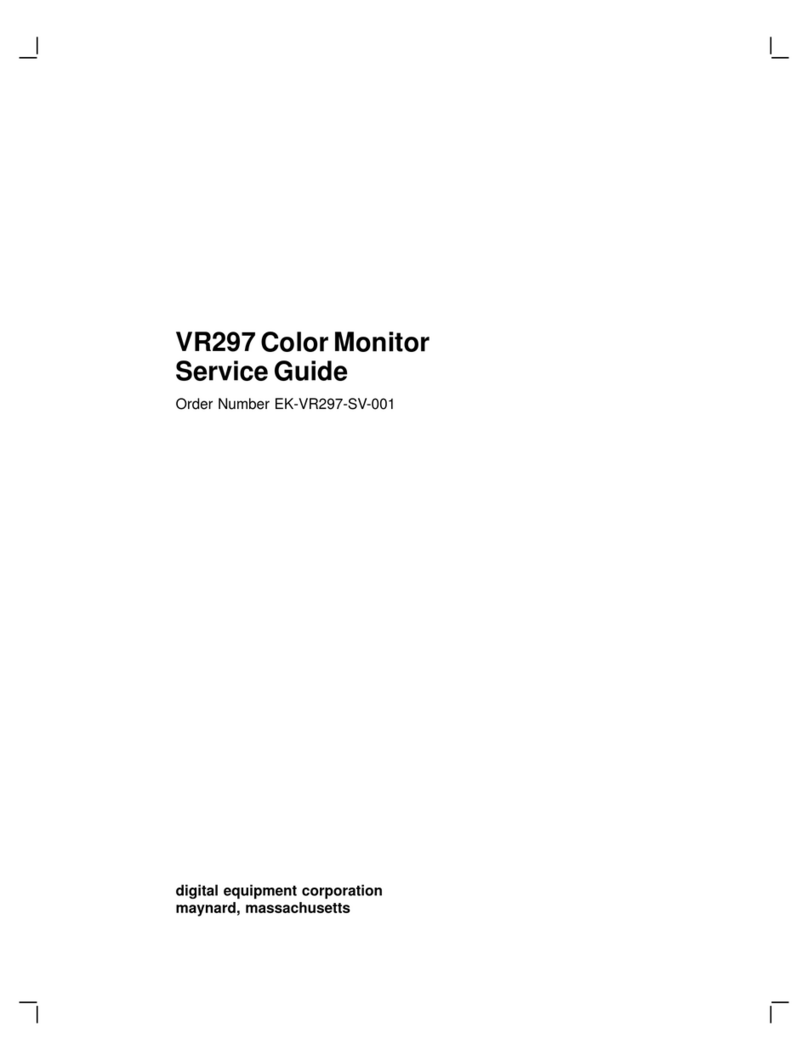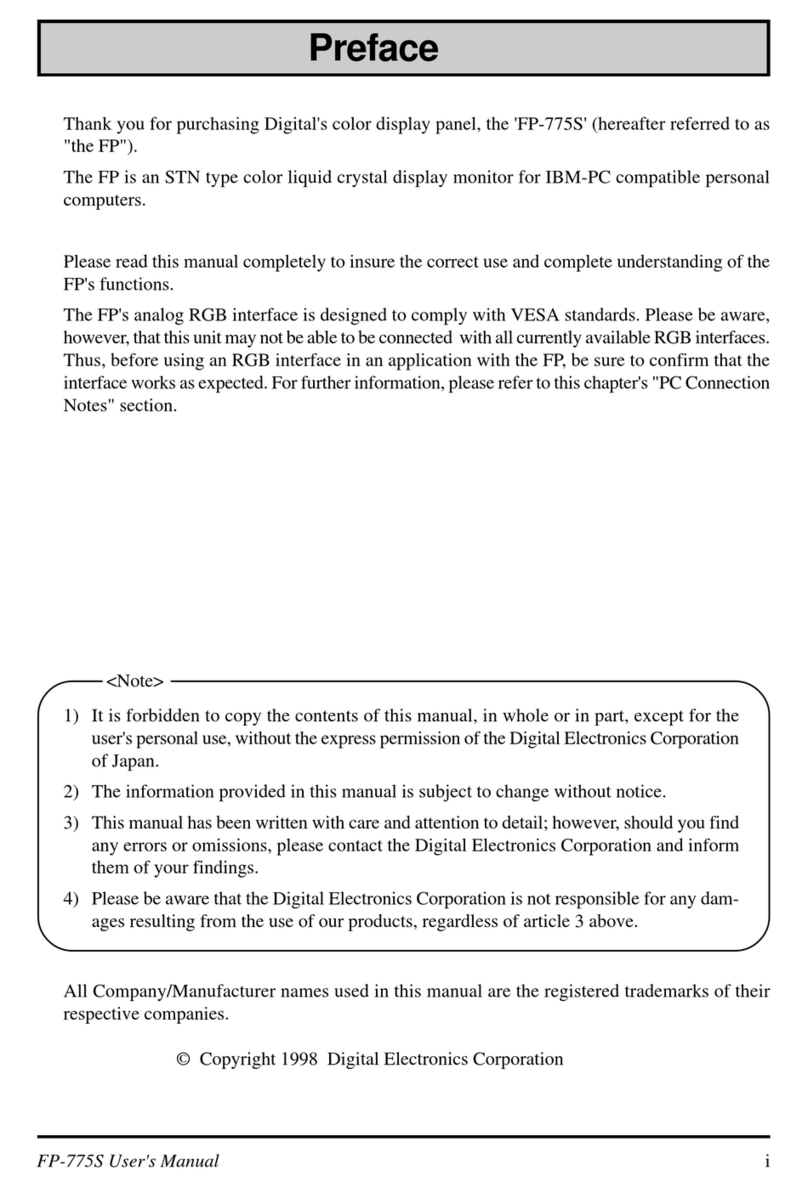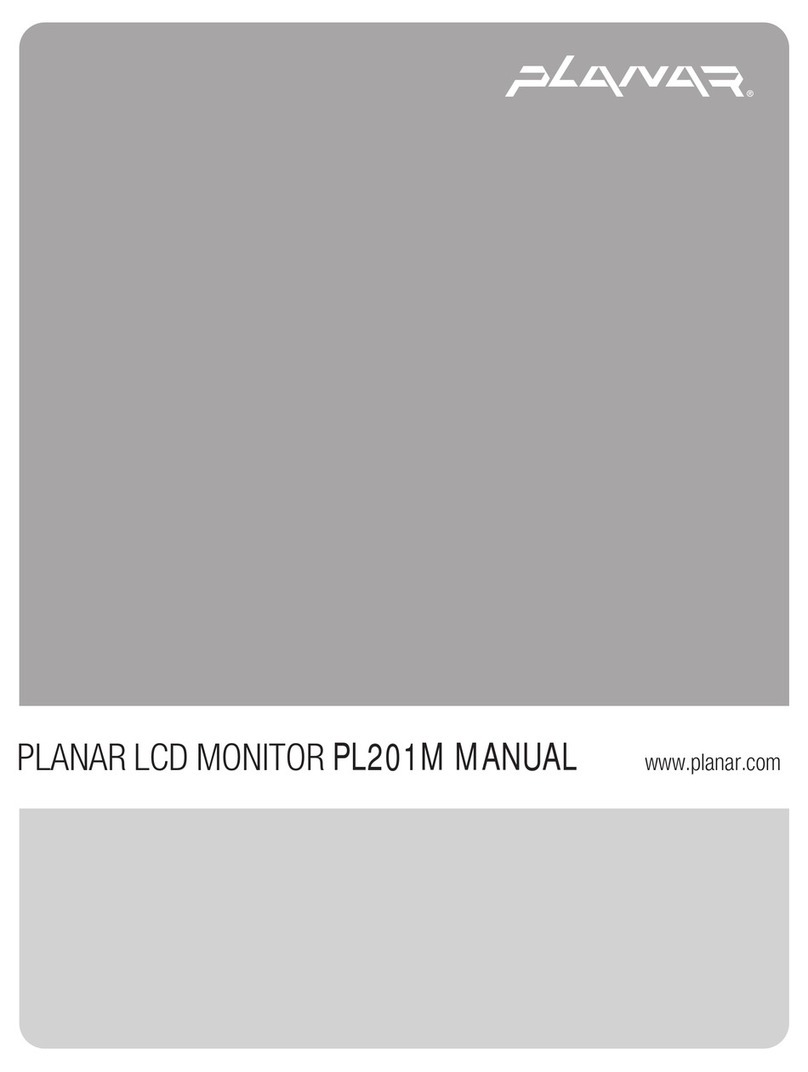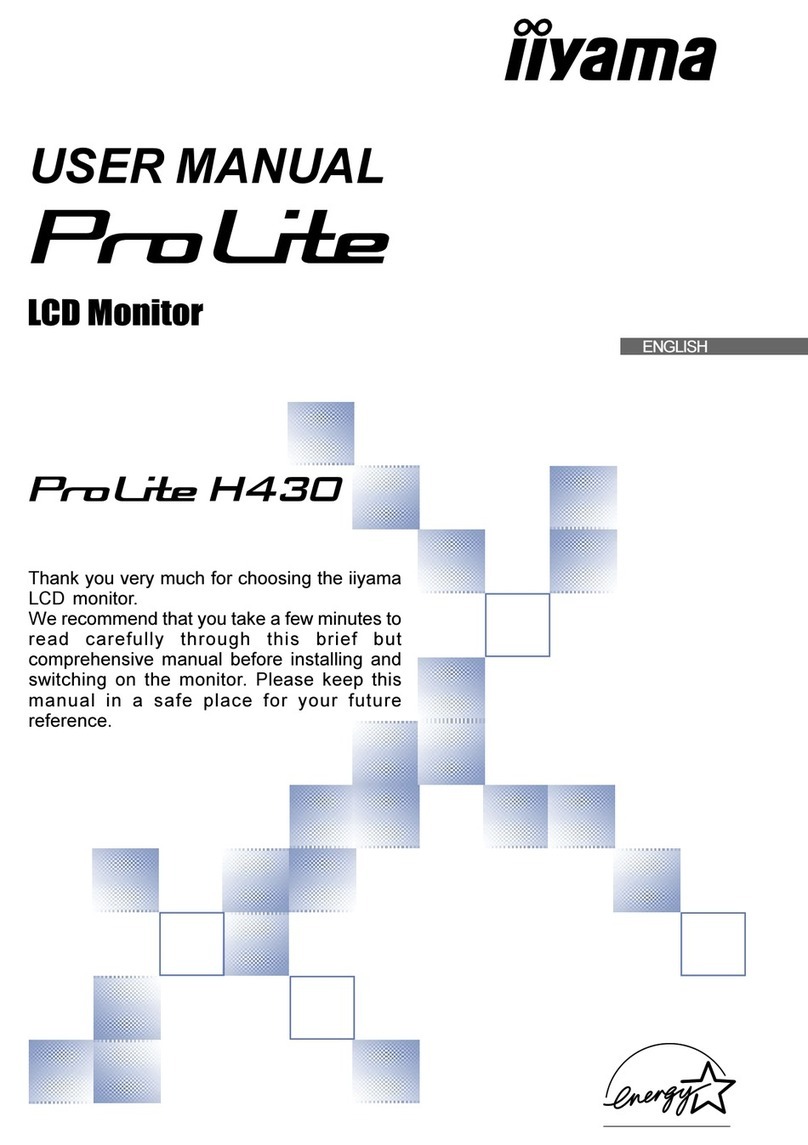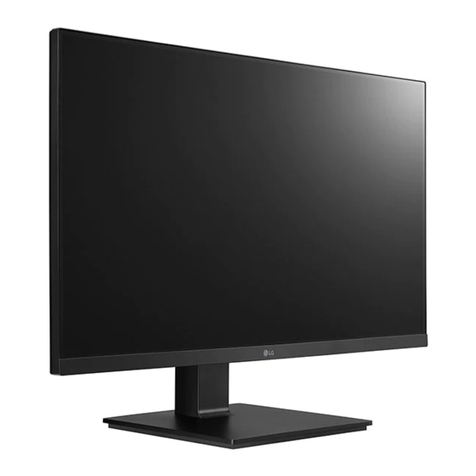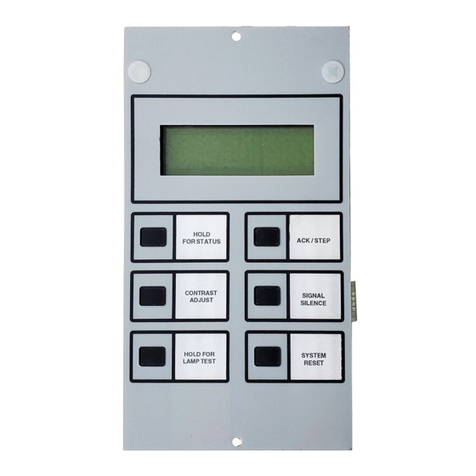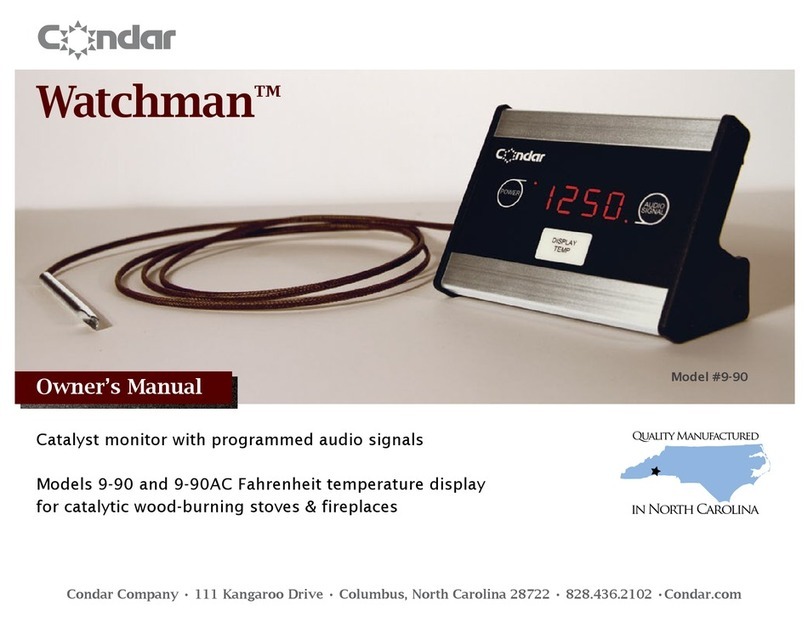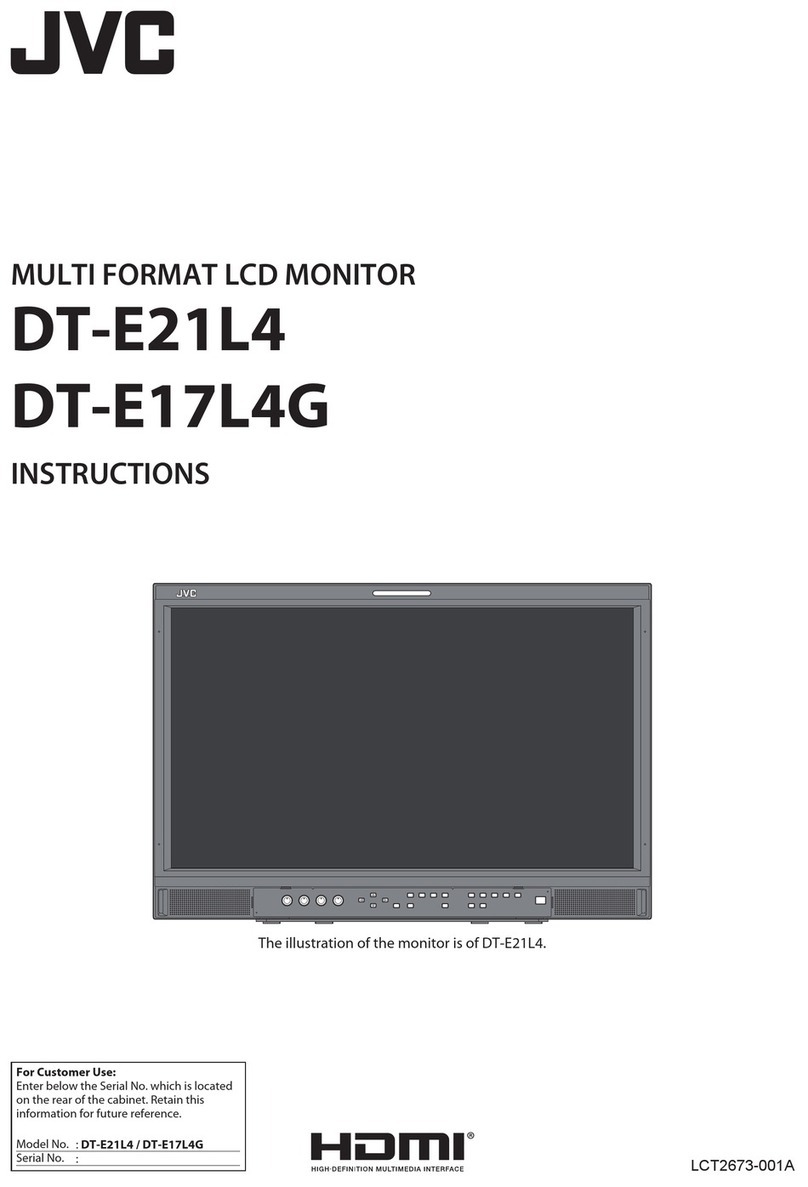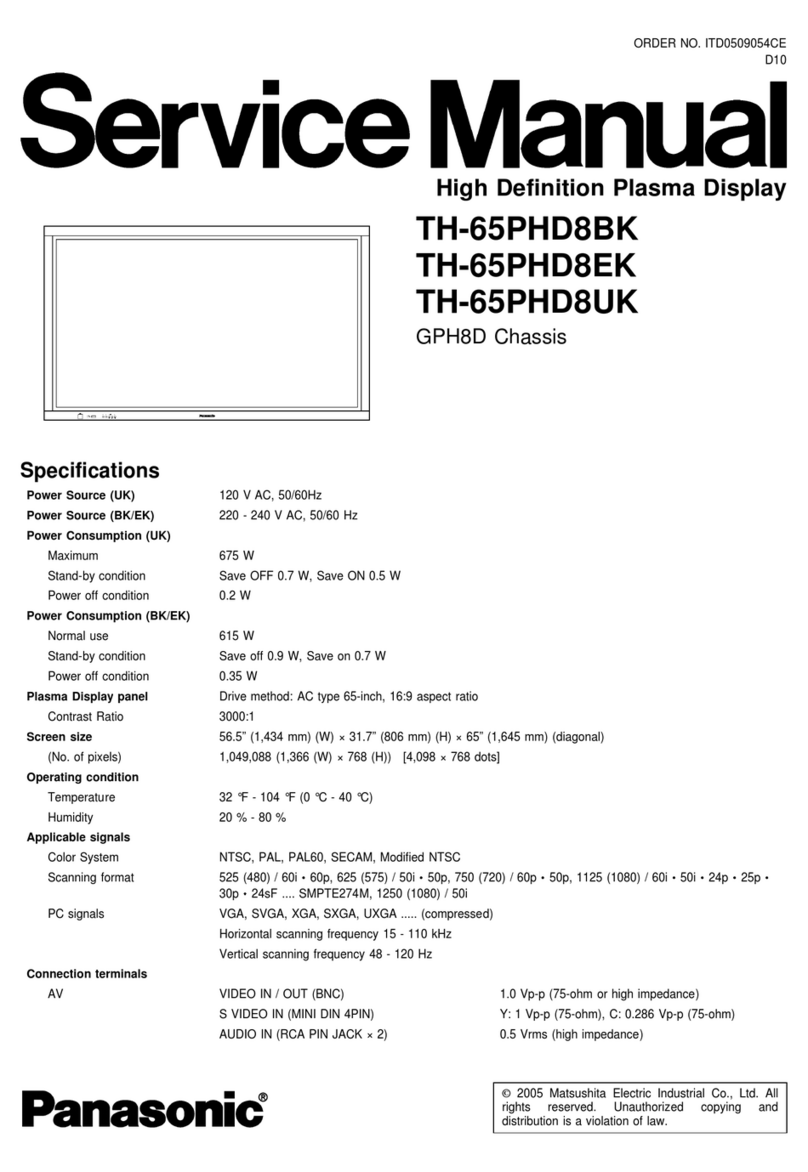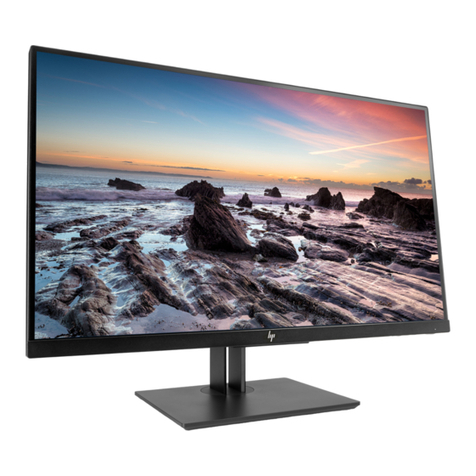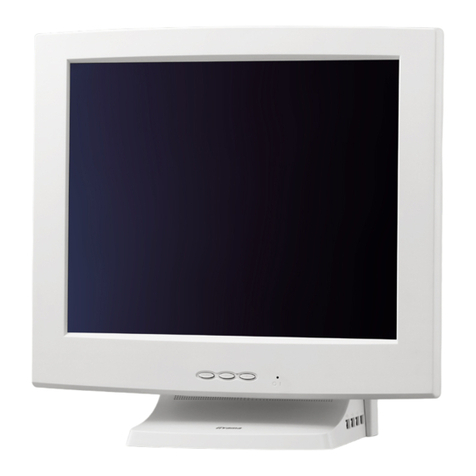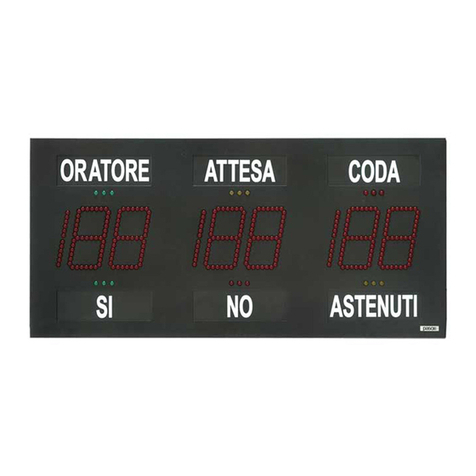DEC VR14 User manual

VR14/VR17
CRT
display
monitor
user's
manual

VR14/VR17
CRT
display
monitor
user's
manual
EK-VR14-0P-005
digital
equipment
corporation:.
maynard.
massachusetts

1st Edition, April 1971
2nd Printing (Rev) June 1971
3rd Printing (Rev) June 1972
4th
Printing (Rev) January 1973
5th Printing, July 1973
2nd Edition, December 1973
7th
Printing, November 1974
Copyright © 1971,1972, 1973, 1974 by Digital Equipment Corporation
The material in this manual
is
for infonnational
purposes and
is
subject to change without notice.
Digital Equipment Corporation assumes no respon-
sibility for any errors which may appear in this
manual.
Printed in U.S.A.
The following are trademarks
of
Digital Equipment
Corporation, Maynard, Massachusetts:
DEC
FLIP
CHIP
DIGITAL
PDP
FOCAL
COMPUTER
LAB

CHAPTER 1
1.1
1.2
1.3
CHAPTER 2
2.1
2.2
2.3
2.4
2.5
CHAPTER 3
3.1
3.2
3.3
3.4
3.5
3.6
3.6.1
CHAPTER 4
4.1
4.2
4.2.1
4.2.2
4.3
4.3.1
4.3.2
4.3.3
4.3.4
4.3.5
CHAPTER 5
APPENDIX A
APPENDIX B
APPENDIXC
CONTENTS
Page
GENERAL INFORMATION
INTRODUCTION
......................................
1-1
SPECIFICATIONS
.....
. . . . . . . . . . . . . . . . . . . . . . . . . . . . . . .
..
1-1
BLOCK DIAGRAM DESCRIPTION
.............................
1-3
OPERATION
INSTALLATION
......................................
2-1
FRONT PANEL CONTROLS
................................
2-1
REAR
PANEL CONNECTORS
...............................
2-2
INTERNAL CONTROLS
..................................
2-2
INPUT SIGNAL REQUIREMENTS
.............................
2-2
THEORY OF OPERATION
X-
AND Y- DEFLECTION CIRCUITS
..........................
"
3-1
PLUS AND MINUS
LOW
VOLTAGE REGULATED SUPPLY
...............
3-5
CRT ELECTRODE VOLTAGES
.............................
" 3-6
HIGH VOLTAGE POWER SUPPLY
.............................
3-6
W682 AND W684 INTENSITY CIRCUITS
.........................
3-10
LIGHT PEN AMPLIFICATION
...............................
3-13
375 Light Pen
.....................................
3-14
MAINTENANCE
PREVENTIVE MAINTENANCE
..............................
4-1
TROUBLESHOOTING
...................................
4-1
No Picture
.......................................
4-1
Faulty Picture
.....................................
4-5
ASSEMBLY REPLACEMENT INSTRUCTIONS
......................
4-5
Deflection
Heat
Sink Removal
.............................
4-5
7007165 Power Regulator Assembly Removal
........
. . . . . . . . . . .
..
4-7
Regulator Heat Sink Removal
.............................
4-9
Yoke and CRT Removal
................................
4-9
High Voltage Supply Removal
.............................
4-11
ENGINEERING DRAWINGS
POWER SUPPLY TROUBLESHOOTING
DEFLECTION AMPLIFIER TROUBLESHOOTING
A225 REPAIR
iii

Figure No.
1-1
1-2
2-1
2-2
3-1
3-2
3-3
3-4
3-5
3-6
3-7
3-8
4-1
4-2
4-3
4-4
4-5
Table No.
1-1
2-1
2-2
2-3
3-1
4-1
5-1
5-2
ILLUSTRA
nONS
Title
Block Diagram
ofVR14
Without Light Pen
Option
VRI4L/VRI7L
Block Diagram
Input
Power Jumper
.....
Locations
of
Internal Controls
X and Y Deflection Circuit . .
G836 Circuit Board,
Part
of
the 7007165 Power Regulator Assembly
Intensity Amplifier W682, Circuit Schematic
W684 Intensity Control
...........
.
G838 Circuit Diagram
............
.
VRI4L/VRI7L
Brightness and Contrast Control
Light Pen Amplifier
........
.
Light Pen Pulse Timing,
G840
Module
VRI4/VRI7
Interior View
....
.
Deflection Heat Sink Removal
..
.
7007165 Power Regulator Assembly
7007165 Removal
.....
Regulator Heat Sink Removal
TABLES
VR14
and
VR17
Configurations .
J17 Rear Connector Pin Assignments
J18
Rear Connector Pin Assignments
Control Settings
........
.
Brightness Control
.......
.
VRI4/VRI7
Voltage Check Points
VR14
Engineering Drawings
VR17
Engineering Drawings
...
Title
iv
Page
1-4
1-5
2-1
2-6
3-3
3-7
3-9
3-10
3-11
3-12
3-13
3-14
4-3
4-6
4-7
4-8
. 4-10
Page
1-1
2-3
2-5
2-7
3-12
4-2
5-1
5-1

WARNING
Maintenance procedures should be performed
by qualified service personnel only.
High
voltages are present within the unit and,
under certain conditions, are potentially
dangerous.
All
electrical safety precautions
must be observed.
Inherent implosion protection
is
employed in
the CRT design; however, the tube may be
damaged
if
it
is
subjected to rough treatment
or
dropped while being removed from or installed
in the display. Exercise caution during these
operations.


1.1 INTRODUCTION
The VR14 and VR17 are completely self-contained CRT
display monitors that require only analog
X-
and Y-position
information and an intensity input, to generate sharp,
bright displays. The VR14 and VR17 are electrically
identical. The VR17, however, has a larger display screen
(17 inches diagonal) than the VR14
(12
inches diagonal).
This necessitates a correspondingly larger enclosure, and a
CRT support bracket for the VR17. Except for the CRT
itself,
both
VR14 and VR17 are composed
of
fully solid
state circuits, utilizing high-speed magnetic deflection to
enhance brightness and resolution. The inputs for the
X-
and Y- deflection may be balanced or single ended, bipolar
or offset, and positive- or negative-going without any
modification
to
the VR14/VR17.
The VR14 and VR17 come in several configurations, listed
in Table 1-1.
Table
1-1
VR14 and VR17 Configurations
Designation Mounting Power Light Pen
Option
VR14-0 Rack
115V
No
VR14-A Rack 230 V No
VR14-B Rack
100V
No
VR14-C Table
115V
No
VR14-D Table 230 V
No
VR14-E Table
100V
No
VR14-LC Table 115 V Yes
VR14-LD Table 230 V
Yes
VR17-LC Table 115 V Yes
VR17-LD Table
230V
Yes
The VR14 versions without the light pen option contain a
W682 Intensity Control Circuit Board and a G838 Fault
Protection Circuit Board,
as
well
as
a front panel
CHANNEL switch which operates with the W682 board. In
CHAPTER
1
GENERAL
INFORMATION
1-1
this variation, intensity pulses may be time multiplexed or
gated
by
a separate input to allow the screen to be
timeshared
by
two inputs.
The VR14/VR17 versions with the light pen option
(VR14-LC, VR14-LD, VR17-LC, VR17-LD) do not have
this timesharing capability nor channel selectivity. They
contain a W684 Intensity Control Circuit Board in place
of
the W682, and a G840 Light Pen Amplifier in place
of
the
G838. The G840 circuit board, however, contains the fault
protection circuitry
of
the G838 board.
1.2 SPECIFICATIONS
VR14/VR17 specifications are
as
follows:
Physical:
Height
Width
Depth
Weight
Viewable
VR14
10-1/2 in.
(267
mm)
19 in. (483 mm)
17 in. (432 mm)
75 lb (34 kg)
VR17
15
in. (381 mm)
21-1/2 in.
(546
mm)
27 in. (686 mm)
85 lb (39 kg)
Area 6-3/4 in. X 9 in. 8-1/4 in. X
11
in.
(171.45 X 228.6 mm) (210 X 280 mm)
VR14 and VR17
Spot Size:
<20 mils inside the usable screen area at a brightness
of
30
fL
Jitter:
<
±1
/2
spot diameter
Repeatability:
<±1 spot diameter
(Repeatability
is
the deviation from the nominal loca-
tion
of
any given spot)

Gain Change:
From a
flXed
point on the screen, less than ±0.3% gain
change for each
±1
%line voltage variation
Temperature Range:
0°
to
50° C(operating)
Relative Humidity:
10%
to
90% (noncondensing)
Brightness:
~
30 fL for
VRI4,
~
25
fL for
VRI7;
measured using a
shrinking raster technique
Linearity:
Maximum deviation
of
any straight line
is
~
1%
of
the
line length, measured perpendicular to a best-fit straight
line.
Deflection Method:
Magnetic (70° diagonal deflection angle)
Focus Method:
Electrostatic
High Voltage:
10.5 kV dc nominal (voltage proportional to input line
voltage). Supply
is
self-contained and equipped with a
bleeder resistor.
Shielding:
CRT
is
fully enclosed in a magnetic shield.
Overload Protection:
Unit
is
protected against fan failure or air blockage by
thermal cutouts. Power supply and amplifiers
are
current
limited. Phosphor protection
is
provided against fault
conditions.
Deflection Amplifier
a.
Deflection amplifiers are dc coupled and are capable
of
sustaining a full screen
ac
or dc deflection
at
environmental extremes.
b. Input Specifications:
1.
Inputs are differential.
2. Differential input impedance,S
kQ
minimum.
3. Input sensitivity, 500 mY/inch maximum (200
mVlinch with resistor change)
1-2
4. Common mode rejection ratio,
40
dB
5. Maximum operating input,
±6
V.
(Maximum oper-
ating input
is
the sum
of
the common mode input
and the differential input.)
6. Input offset not to exceed ±1/2 peak-to-peak
input signal.
7. Maximum nonoperating input, ±50 V
c.
Full screen deflection and settling time to within
±1
spot diameter, ~ 18
}J.S.
d. Small signal settling time to within 1/2 spot diameter,
~1
}J.s
for a 0.1 inch deflection
e.
Small signal linear
slew
rate,
~
0.4 inch/l
}J.S
f.
Velocity error coefficient, 500
ns
maximum (average
ramp delay between input and output)
Z-Axis (on VR14 without Light Pen Option)
a.
Z-Input - A negative transition from ~ +2.4
V,
but
not exceeding
+8
V, to
~
+0.8 V, but not more
negative than
-4
V, in
~
20 ns, causes an unblanking
pulse at the CRT cathode from approximately +62 V
to
ground with a duration
of
~
200
ns
at the 50
percent points. Delay between the 50 percent point
of
the negative input transition
to
the 50 percent
point
of
the output pulse
is
less
than 100 ns. Driver
must sink 4 rnA.
b. Z-Direct - A positive-going pulse not exceeding
65
V,
but at least 45 V in height and not exceeding
10
}J.S,
but
at least 1
}J.S
in duration, unblanks the CRT
to
a
viewable intensity. This signal
is
ac
coupled to the
CRT grid.
c."
Channel Select -With the Channel Select Switch in
the
Channell
position, a positive level
of
greater than
+2.4 V, but not exceeding
+8
V, enables the Z-input
circuit. A level
of
less
than +0.8 V, but not more
negative than
-4
V, disables the circuit. With the
switch in the Channel 2 position, a positive level
disables the Z-circuit; a negative level enables it.
Placing the switch in the Channel 1 & 2 position
disables this input.

Z-Axis [on VR14/VR17 with Light Pen Option (VR14L
and VR17L)]
a.
Z-Input -This
is
a TTL logic signal. When a TTL
low, it unblanks the CRT by causing the cathode
voltage to change from approximately +62 V
to
ground. The CRT will remain unblanked
as
long
as
the Z-input
is
at a logic low.
b. Intensity
0,
1, 2 - These three signals, together
with"
the brightness control, generate a voltage
of
from
-80 V to 0 V on the CRT grid 1,
to
determine image
brightness. The combination
of
the three intensity
signals asserts one
of
eight possible analog voltages,
which in turn
is
ANDed with the output
of
the
brightness control to generate a grid voltage in the 0
to -80 V range. Thus, there are eight intensity levels
at each
of
the infinite positions
of
the brightness
control.
Power
a.
All
power supplies necessary for operation
of
the unit
are self-contained.
b. Input Requirements
Voltage: (Selectable by tap changes)
100 V ±
10%
115 V ±
10%
230 V ±
10%
Frequency -
50-60
Hz
Power -
::;:;;;;
500 W
Current -
::;:;;;;
5 A
Type -Single Phase
1.3
BLOCK
DIAGRAM DESCRIPTION
Figure I-I
is
the functional block diagram
of
the VR14
without the light pen option. The
X-
and Y- position signals
are connected to their respective A225 Deflection Ampli-
fier Circuit Boards. The A225s boost the input signal to a
level sufficient
to
drive the power transistors, while also
providing gain and position controls. In turn, the power
transistors drive
the
deflection yoke that positions the
electron beam on the screen. The yoke currents are then
passed through a 0.5 n resistor that converts the yoke
currents back into voltages that are used
as
feedback for
each A225 deflection amplifier. This feedback allows the
A225 to produce an exact current replica in the yoke
of
the
input signals.
The intensity input
is
applied to the W682 circuit board
that converts this input to a 60 V pulse which drives the
cathode. The cathode pulse
is
negative going; this pulse
turns on the electron beam, creating a spot on the screen.
1-3
The W682 accepts a gating input that allows the intensity
pulse
to
be time-multiplexed between two input sources.
The G838 Fault Protection Board disables the intensity
circuit in the event
of
a ±22 V failure. This prevents the
phosphor screen from burning,
as
there would be no
deflection under these conditions.
Line power
is
passed through a fuse, an on-off switch, and
then through one normally closed thermal cutout switch.
The switch
is
located
on
the +22 V regulator heat sink, and
in the event
of
a
fan
failure or excessive temperature on the
heat sink,
VRI4/VRI7
input power will be shut off until
it
cools down. The line power
is
then connected to the power
transformer, the high voltage power supply, and the fans.
The high voltage supply converts the input line voltage to
10.5 kV
that
is
connected to the CRT anode. The power
transformer has three basic secondaries: a 6.3 V for fila-
ment, a 70/150 for CRT electrodes, and a 72 V center
tapped for deflection. The 72 Vac
is
rectified and filtered
to provide ±43 Vdc unregulated. This ±43 Vdc
is
regulated
with circuits on the G836 board, along with four power
transistors on the regulator heat sink assembly. The
regulated output
is
±22 Vdc and
is
distributed to the
deflection amplifiers. The 70/150
ac
is
rectified and filtered
on the G836 to generate ±80 Vdc and +400 Vdc. The
-80
Vdc
is
used for the brightness potentiometer which
is
tied to the grid. One side
of
the brightness control
is
connected
to
another potentiometer on the G836 which
can
adjust the maximum brightness range
of
the brightness
potentiometer. The +400 Vdc
is
supplied directly to grid 2
and also
to
one side
of
the focus potentiometer on the
G836 board. The wiper
of
the focus potentiometer goes
directly to the focus electrode on the CRT.
Figure
1-2
is
a block diagram
of
the
VRI4L
and VRI7L,
i.e.,
VRI4/VRI7
with the light pen option. Note that the
G840 Light Pen Amplifier replaces the G838 Fault Protec-
tion Circuit Board. The G840 contains the G838 circuitry
as
well
as
an amplifier to detect and shape
pdse
outputs
from the light pen. The output
of
the light pen amplifier
is
brought out
of
the
VRI4L/VRI7L
through pin
19
of
the
24-contact amphenol connector (117) at the rear
of
the
display monitor.
Note that
in
the
VRI4L
and
VRI7L,
the W684 intensity
control replaces the W682. The W684 allows an intensity
pulse to the cathode whose duration
is
equal to that
of
the
Z intensify signal. The W684 circuitry also modifies the grid
I bias voltage, thereby allowing eight intensity levels for a
particular setting
of
the front panel brightness control.
All
other circuits represented in Figure
1-2
are
identical
to
those represented in Figure
I-I.

115~o---l
VAC
INPUT
»-----------,
l I
FROM
THERMAL
CUTOUT
115VAC~
115VAC
POWER
TRANSFORMER
115
VAC
UNIT
POWER
RECTIFIERS
+ FILTER
CAP.
CHANNEL
1>---------------~~~----~
CHANNEL
2»--------~o
Z INTENSITY
>--------------
....
+22V
-22V
POWER
SUPPLY a
REGULATOR
BOARD
G836
+80V
X FEEDBACK
X INPUT
>-------------t
THERMAL
CUTOUT
~-------+
+22V
~------+
-22V
~------+
FOCUS
X
POWER
TRANSISTOR
y
Y INPUT
>---------1"
~~~tl~~~~N
~_---I"
PO~ER
A225
RANSISTOR
115VAC
HIGH
VOLTAGE
POWER
SUPPLY
10.500VDC
ANODE
0.5
J'l.
.?"'I---~+-~-
CURRENT
SAMPLE
+20V
-20V
~t
GAIN Y
IpOSITIONI
r;;;l---<
115
L.:.::.J----<
VAC
0.5.n.
CURRENT
SAMPLE
Y
FEEDBACK
CP-0758
Figure
1-1
Block Diagram
ofVR14
Without Light Pen Option

115~~
VAC
I
FROM
THERMAL
CUTOUT
INPUT
)>-------------,
1
115VAC
POWER
TRANSFORMER
115
VAC
UNIT
POWER
RECTIFIERS
+ FILTER
CAP.
INTENSITY
0'>--------------.....,
l~tt~~IH
1
>-
__________
----I~L---__,
POWER
SUPPLY a
REGULATOR
BOARD
GS36
THERMAL
CUTOUT
~------+
+22V
~------+
-22V
r-------.
FOCUS
~------++400V
~------+
+SOV
~--------+
-SOY
r--~-'---......L.----1
DEFLECTION
YOKE
115VAC
HIGH
VOLTAGE
POWER
SUPPLY
10,500VDC
ANODE
INTENSITY
OUT
C>-------------~
~--__=_------:---==::;j~~-~.i:~==~
LIGHT
PEN
INPUT
+22V
-22V
LIGHT
PEN
PULSE
-x
INPUT
>------~
+YINPUT>------~~
-Y
INPUT>----------~
Y
FEEDBACK
Figure
1-2
VR14L/VR17L Block Diagram
0.5.n.
,2>----+--iI-+-
CURRENT
X
POWER
TRANSISTOR
Y
POWER
RANSISTOR
+22V
-22V
r;;:;l---<
115
L..::J----<
VAC
SAMPLE
0.5
J),
CURRENT
SAMPLE
cp-
0760


2.1 INSTALLATION
The VR14
is
shipped either
as
a standard RETMA 19 inch
by
10-1/2 inch
(l0-7/16
inch) rack-mounted unit or
as
a
table-top model (without chassis slides) with its own
decorator cover. 'The VR17 comes only in a table-top
model. The
VR14/VR17
can operate from a power line
frequency between
47
and 63 Hz. The
input
line voltage,
however,
is
specified
by
a letter designation after the
VR14/VR17
(O,C
is
115 V; A,D
is
230 V; and B,E
is
100
V). The
VR14/VRI7
can operate with any
of
the three
input
line voltages simply
by
changing
the
jumpers and
interconnections
on
TB1 and TB2 (Figure
2-1
and drawing
D-CS-7007084-0-1).
Equipment cooling
is
the most important VR14/VR17
installation requirement. Fans draw air from
the
bottom
of
the
unit; therefore,
at
least 1 inch
of
free air space must be
provided below
the
bottom
chassis.
The
table-top model
keeps the
bottom
1 inch above the table surface. In the
rack-mounted unit,
if
equipment
is
mounted immediately
below the
VR14,
as
long
as
there
is
open area under the
VR14 fans (a screen
is
acceptable; a solid plate closer than
1 inch
is
not),
proper cooling can occur. The same
requirements apply,
on
the rack-mounted unit,
to
the area
immediately above the unit. The table-top model has a solid
top
cover. The cooling air exits from
the
rear
of
the
unit.
Therefore, at least 2 inches
of
free space must be provided
immediately behind
the
unit. (Do
not
push the
VRI4/VRI7
flush against a wall or solid vertical surface
that
would cut
off
air circulation.)
NOTE
Before applying power
to
the
VR14/VR17,
ensure
that
the
position potentiometers are set
for the particular input signals being used.
Because
of
the
universal nature
of
allowable
input
signals,
the
deflection amplifiers may be
driven
into
saturation far
off
screen
by
position
settings. Leaving the deflection amplifiers satu-
rated way off screen continuously may cause
damage. See Paragraph 2.S and Table 2-2 for
propersettings.
2-1
Interchange
Orange
with
Red
(from
Transformer)
TBl
TBl
1
(2)
3
4
5
@
TBl
CHAPTER
2
OPERATION
115 Vac
TB2
1
~
__
~ju_m~p_er
____
~~
3
4
5
~
__
~ju_m~p_er
____
~@
230 Vac
TB2
1
~
jum
3
per 4
5
®
100 Vac
TB2
jumper
4
5
jumper ®
Interchange
White
with
Gray
(from
Transformer)
Figure
2-1
Input
Power Jumper
2.2 FRONT PANEL CONTROLS
The on/off, brightness control, and
the
channel select
control
(not
applicable to
VRI4L/VRI7L)
are located
on
the front panel. The
on/off
switch turns on input power
to
the
VRI4/VRI7
when the
knob
is
rotated clockwise from
the maximum counterclockwise
off
position. Turning the
knob clockwise also increases the brightness
of
the dis-

played information. A delay
of
about
30
seconds occurs
before information appears
on
the
screen while the CRT
filament warms up. In an operating system,
it
is
recom-
mended that power be left on the display even when
it
is
not
in continuous use
so
that
the
filament warmup delays
do
not
occur.
The channel select switch
on
VR14s without the light pen
option works in conjunction with the channel select signal
applied at the rear connector. When
not
using the dual-
channel feature,
the
select switch should be in the 1 & 2
position. When using the dual-channel system, points
on
the
screen will be intensified from Z-intensity inputs only when
the channel select signal at the rear connector
is
high and
the channel select switch
is
in
the
Channell
position.
If
the
channel select
input
signal goes low while the select switch
is
at 1, intensification ceases. On the
other
hand, the
Channel 2 position works in the opposite manner.
If
the
channel select
input
signal
is
low and the select switch
is
at
2, Z-intensification signals will intensify on the screen.
Thus,
if
a group
of
information points
is
to
be separated
from another group, separation can be achieved
by
having
group 1 intensification pulses occur only when the Z-select
line
is
high, and group 2 intensification pulses occur only
when
the
Z-select line
is
low. Channel select position 1 & 2
overrides
the
select
input
signal and displays every intensifi-
cation pulse
of
both
channels at once. To observe only
Channel 1 information, select Channel 1 and all Channel 2
signals are locked out. By selecting Channel 2, only Channel
2 signals are displayed.
2.3 REAR PANEL CONNECTORS
The rear panel has an Amphenol 14·contact connector
(JI8)
and an Amphenol 24-contact connector
(JI
7). Tables
2-1
and 2-2 list rear connector pin assignments.
2.4 INTERNAL CONTROLS
The
VR14/VRI7
internal adjustments include six potenti-
ometers: X position, X gain, Y position, Y gain, focus, and
brightness preset. Access to the adjustments
is
gained by
removing
the
case cover (Figure 2-2).
The gain and position adjustments are located
on
the top,
left central portion
of
the VR14/VR17 (as viewed from the
front). The two forward potentiometers on the deflection
circuits are the horizontal gain
on
the left, and vertical gain
on
the
right. The two rear potentiometers are the hori-
zontal position
on
the left, and the vertical position
on
the
right.
The gain adjustments allow
the
VR14/VR17
to
accom-
modate a range
of
input signal amplitudes and expand or
contract the horizontal and vertical deflection to suit full
screen requirements. The position controls accommodate a
2-2
variety
of
input
signals and allow offset inputs
to
be
centered on the CRT screen. Once initially adjusted for the
particular
input
Signals
used, the gain and position controls
rarely have to be adjusted. Gross positioning
off
screen or
excessive gain deflecting
off
the
extremities
of
the screen
should be avoided, since the deflection amplifiers will go
into current limiting and may overheat
if
allowed
to
stay in
this condition any length
of
time. Turning the X and Y gain
controls clockwise, increases
the
gain or displayed image
size. Turning
the
X and Y positions clockeise moves the
displayed information right and up, respectively.
The focus and brightness preset adjustments are located at
the
top,
right central portion
of
the
unit. They are
on
the
power supply regulator circuit (G836)
that
is
somewhat
recessed from
the
top
of
the unit. The brightness preset
is
the rear-most
of
the two. This potentiometer allows the
range
of
the
front panel brightness control
to
be limited
to
any maximum brightness desired. Turning
the
brightness
preset counterclockwise increases the maximum brightness
range
of
the
front panel control. Generally, this control
is
set so
that
at maximum brightness setting
on
the front
panel knob,
the
displayed information does
not
"bloom"
causing a degradation in resolution. The focus potenti-
ometer
is
in front
of
the
brightness preset. The adjustment
is
quite insensitive and requires several turns
to
go through
focus.
The VR14L and
VR17L
also contain a contrast adjusting
potentiometer (R29), located
on
the
W684 module.
It
is
accessible from
the
top
of
the
VR14/VR17. This control
is
used to extend or contract the brightness range
of
the CRT
display.
It
does
not
normally have
to
be changed after an
initial adjustment
is
made
to
compensate for component
variations.
2.5 INPUT SIGNAL REQUIREMENTS
NOTE
The deflection amplifiers must
not
be driven so
that
the
CRT beam
is
off
screen for any length
of
time
or
permanent damage may occur.
Ensure
that
input
deflection signals fail
to
a
safe, on-screen value.
The VR14/VR17 requires analog voltage inputs for
X-
and
V-deflection, and a logic level change or pulse for intensify.
The
X-
and V-inputs are identical. However, because the
CRT
is
a 3 X 4 rectangle, only
3/4
of
the horizontal
deflection
is
required for full vertical deflection. The
deflection inputs are differential
but
may be driven from
single-ended sources. When using single-ended sources, the
differential input
is
helpful in eliminating annoying ground
loops and hum. By carrying
the
"local" common or ground

Table
2-1
117 Rear Connector Pin Assignments
VR14 VR14
L/VRI7
L
11724-Pin Destination Signal Name Function Signal Name Function
Connector
Pin 1
A4L
Z-Select High input enables Z-intensify
to
Intensity 2 Determines intensity level
occur
if
channel select switch on
1.
A
low input enables Z-intensify
to
occur
if
channel select switch on 2.
Pin 2
A4B
Not Used Intensity 0 Determines intensity level
Pin 3
A4K
Not Used Intensity 1 Determines intensity level
Pin 4
A4J
Z-Input When this input goes from high to low, Z-Input
When
this input
is
low, an intensify
an intensify pulse
is
generated. signal
is
applied to the CRT.
Pin 5 GND
Pin 6 GND
Pin 7
A2B
-X
Input One side
of
X~input
signal line -xInput One side
of
X-input signal line
Pin 8
A2E
+X
Input Other side
of
X input signal line +X Input Other side
of
X-input signal line
(ground for single ended input) (ground for single ended input)
Pin 9
A2H
X-Signal
GND
X signal reference ground X-Signal GND X signal reference ground
Pin 10
A3B
-Y
Input One side
of
V-input signal line
-Y
Input One side
of
Y-input signal line
Pin
11
A3E
+Y
Input Other side
of
Y input signal line +Y Input Other side
of
Y input signal line
(ground for single ended input) (ground for single ended input)
Pin 12
A3H
V-Signal
GND
Y signal reference ground V-Signal GND Y signal reference ground
Pin
13
A4D
Z-Direct Input signal that directly modulates Not Used
CRT grid (ac coupled)
Pin
14
N/C

Table
2-1
(Cont)
J1
7 Rear Connector Pin Assignments
VR14
VRI4L/VRI7L
J1724-Pin Destination Signal Name Function Signal Name Function
Connector
Pin
15
JI8-Pin4
Not Used Bell (Speaker) Used in LK40 option
Pin
16
N/C
Pin
17
JI8-Pin
5 Not Used
+K.B
Signal Used in LK40 option
Pin 18
JI8-Pin
6 Not Used -
K.B
Signal Used in LK40 option
Pin
19
AIH
Not Used Light Pen Out Amplified light pen pulses
Pin 20
JI8-Pin
12 Not Used
+5
VIN
Used in LK40 option
Pin
21
N/C
Pin 22
JI8-Pin
8 +22 V +22 V
is
available
if
JI8-Pin
8
is
+22V
+22 V
is
available
if
JI8-Pin
8
is
jumpered
to
JI8
pin
1.
jumpered to J18 pin 1.
Pin 23
JI8-Pin
10
-22
V -22 V
is
available
if
JI8
pin 10
is
-22 V
is
available
if
JI8
pin
lOis
jumpered
to
JI8
pin 3. jumpered
to
JI8
pin 3.
Pin 24
JI8-Pin9
GND
JI8
pin 9 must be jumpered to
JI8
pin GND
JI8
pin 9 must be jumpered
to
JI8
2. pin 2.

Table 2-2
Jl8
Rear Connector Pin Assignments
Jl8
14-Pin Connector Destination
Pin 1 +22 V Regulated
Pin 2
GND
Pin 3 - 22 V Regulated
Pin 4 117 Pin
15
Pin 5 117 Pin
17
Pin 6 117 Pin
18
Pin 7 N/C
Pin 8 117 Pin 22
Pin 9 117 Pin 23
Pin 10 117 Pin 24
Pin
11
N/C
Pin 12 117 Pin 20
Pin
13
GND
Pin 14
-22
V
along with the deflection signal from where it
is
generated,
a quasi-differential signal
is
generated. Instead
of
termi-
nating this ground at the
VRI4/VRI7
chassis,
use
the
ground
as
if
it
were one side
of
a differential signal (the
other side being the deflection signal itself).
The,
VRI4/VRI7
uses
the deflection signal with respect to its
own ground and not the
VRI4/VRI7
ground, which, most
likely, is different and could cause picture ripple and hum.
If
a separate ground
is
not available, the single deflection
Signal
is applied to one side
of
the differential input. The
remaining differential input
is
terminated with the source
impedance
of
the driving signal or,
if
this
is
low, the input
is
simply grounded (signal ground not chassis ground). (Signal
ground
is
pin 9 and pin
12"
X-
and Y
-signal
ground,
Signal Name Function
+22 V For
VRI4/VRI7
options
GND
For
VRI4/VRI7
options
-22
V For VR14/VR17 options
Bell
(Speaker) Used with LK40 option
+KB
Signal Used with LK40 option
-KB
Signal Used with LK40 option
Not Used
+22 V Jumpered from J18 pin 1 to 118 pin
8 by P18
GND
Jumpered from 118 pin 2 to 118 pin
9 by P18
-22V
Jumpered from 118 pin 3 to 118 pin
10 by P18
+5V
Provides
+5
V to LK40 option
GND Provides
GND
to
LK40 option
-22
V Provides
-22
V to LK40 option
respectively.) Never
use
chassis ground for
X-
and V-input
reference -always
use
Signal
ground.
When
using balanced
or differential inputs, tie each side
of
the twisted-pair
shielded cable to the two inputs and the shield to the signal
ground. The importance
of
using signal ground cannot be
overstated; most noise and washing displays are a result
of
indiscriminate grounding.
.2-5
The minimum voltage
Signal
for full X-deflection
is
2 V
peak-to-peak and 1.7 V for Y when
Rl
and R2 on the
A225 are 3.3
kn
(Figure 3-1). For larger input signals,
Rl
and R2 are normally 10
kn.
With 10
kn,
the maximum
input sensitivity
is
0.5 Vlinch. The input impedance
is
5
kn
minimum for maximum sensitivity
(RI
and R2: 3.3
kn)

POSITION
---r
.........
HORIZONTAL
VERTICAL
5481-1
Figure
2-2
Locations
of
Internal Controls
and 20 kQ minimum for
Rl
and R2 =
10
kQ.
When
driving
long cables (more than 30 feet), high-speed deflection may
not be possible unless the cables
are
terminated in a low
impedance
(less.
than 100 Q) since the VR14/VR17 input
impedance
is
too high for this application.
Input signals larger than 2 V may be used by attenuating
with the gain controls and
Rl
and R2 on the
X-
and
Y-deflection circuit boards. However, the potentiometers
become much too sensitive for input signals greater than
10 V peak-to-peak and
Rl
and R2 should
be
increased to
provide pre-attenuation for these larger input signals. The
input signals may be bipolar such
as
±5
V or unipolar such
2-6
as
0 V to
+5
V or 0 V to - 5
V.
The position potentiometer
allows the deflection to be offset plus or minus half a
screen; thus, a unipolar signal may be completely centered
on the screen. Offsets more than half
of
the full-scale inputs
cannot be handled. In other words, if the full-scale
deflection
is
offset from 0 V by more than half its'full scale
value, centering on the screen cannot be accomplished. A
3 V peak-to-peak deflection signal, for example, may not
be
offset from 0 by more than ±1.5
V.
So
±1.5 V, 0 V
to
-3
V
or 0 V
to
+3
V are
all
acceptable, but a deflection input
that
goes
from +1 V to
+4
V cannot be used until it
is
shifted down a minimum
of
1
V.
Table
2-3
summarizes the
control settings for various inputs.

Input Deflection
±2
Vto
5 V
0,0 = center
+2 V to
+5
V
is
up
and
to
right
oV
to
+2 V to
+5
V
0,0 = upper right
screen
oV to - 2 V
to
- 5 V
0,0 = lower left
Table
2-3
Control Settings
Position Setting
With no inputs, set
X-
and
Y-
position potentiometers to get
o
Vat
A02-A (for X) and A03-A
(for Y).
With no inputs, set
-2.2
V @
A02-A, A03-A with
X-
and
V-position potentiometers.
With no inputs, set +2.2 V @
A02-A, A03-A with
X-
and
Y-position potentiometers.
The Z-intensify input requirement
is
simply a TTL transi-
tion from high to low. In VR14s using a W682 Intensity
Control, this triggers the intensity circuit
to
generate a
300 ns intensify pulse. In VR14Ls and VR17Ls, which
use
the W684 Intensity Control, the intensify circuit
is
trig-
gered, and remains active, until Z-intensify
goes
high.
NOTE
The intensify signal must be delayed from the
X-
and V-position signal for an appropriate
length
of
time to allow the deflection coil to
settle the electron beam to its required posi-
tion. Failure to do
so
displays smeared dots
that are located incorrectly on the screen. Also,
at
least a 500
ns
waiting period must be allowed
to
intensify a dot before commanding the
electron beam to move to its next location. Not
giving enough time to intensify a dot after the
deflection
is
settled
will
also smear the dot,
since the deflection amplifier
will
start "drag-
ging" the dot to the new position. The amount
of
delay required from the time new
X-
and
V-position information
is
presented to the
VRI4/VRI7
and
the
intensify pulse
is
requested depends upon how large a position
change
is
requested and how perfectly settled
the dot has to be to its final ideal position.
Full-scale deflection changes, such
as
far left to
far right or corner to corner, require a 20
J.ls
waiting period for the dot
to
settle to within
0.01 inch
of
its final value.
If
larger errors can
be tolerated, 18
J.ls
may be used. Small deflec-
tion changes require much
less
time. A
0.1
inch
change can be settled in
less
than 1
J.lS.
If
there
2-7
is
no way for the circuits driving the
VRI4/VRI7
to distinguish small position
changes from large ones, each change must be
assumed
to
be large and thus requires the
worst-case delay. Also,
if
the
D/
A converters
driving the display have "gliches" (error spikes
generated while changing values), proportion-
ately longer delays are required since the
deflection amplifiers have to recover from the
"gliches."
The Z-direct input (applicable only
to
VR14s without light
pen option) allows direct modulation
of
the brightness.
Positive-going signals increase brightness. This input
is
not
direct coupled; therefore, dc brightness information cannot
be
used. The
RC
time constant
is
approximately
30
ms.
The
Z-direct may be used with or without the Z-intensify input.
If
Z-direct
is
used with Z-intensify, it can alter the
brightness
of
the normal intensify pulse by adding or
subtracting at the CRT grid. This
is
accomplished by
pulsing the Z-direct with a pulse
of
equal duration with the
Z-intensify.
By
varying the amplitude and polarity
of
the
Z-direct pulse, the dot
will
be
of
a different brightness.
When
using Z-direct without the Z-intensify (such
as
for
vector intensity control or any other non-point plotting
application) the signal must be large enough to overcome
the CRT cutoff. A typical direct signal
will
have 5 V to
10
V
of
actual brightness information riding on top
of
a
40 V pedestal; the
40
V pedestal ensures that the CRT will
reside below cutoff.
The Z-select input (applicable only to VR14s without light
pen option) works in conjunction with the front panel
channel select switch. The Z-select allows the Z-intensify
pulse to be gated or time multiplexed.
When
the channel
select switch
is
on the 1 & 2 position, Z-select inputs have
no
effect
on
the VR14.
When
the channel select switch
is
in
the 1 position, Z-intensification occurs only when Z-select
input
is
a TTL high.
When
the channel select switch
is
at 2,
Z-intensification occurs only when Z-select
is
held at a TTL
low. Thus,
if
two separate pieces
of
information are to be
displayed, by placing Z-select at a high only during Channel
1 intensification times, and low only during Channel 2
intensification times, both curves
will
be displayed when
the channel select switch
is
at 1 & 2, and only Channel 1
when Channel 1
is
selected, and Channel 2 when Channel 2
is
selected.
In the VR14L and VR17L, brightness level
is
a function
of
three input signals [Intensity
(2:0)],
as
well
as
the front
panel brightness control. These input signals combine in the
W684
module
to
generate a voltage which
is
applied to grid
1
of
the CRT, establishing a particular brightness level.
This manual suits for next models
1
Table of contents
Other DEC Monitor manuals
